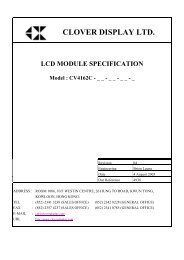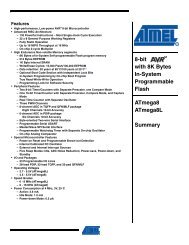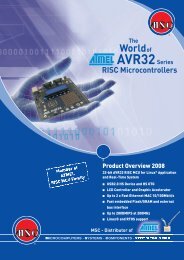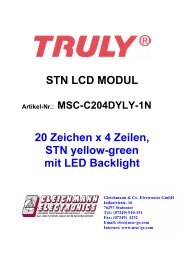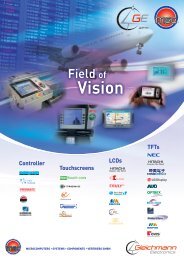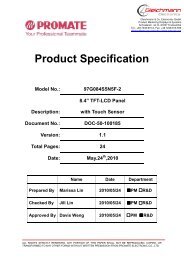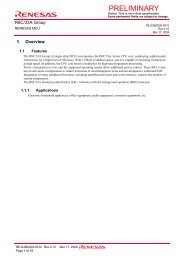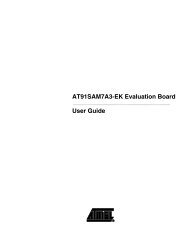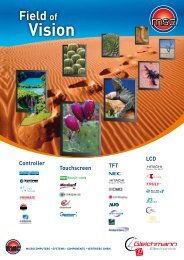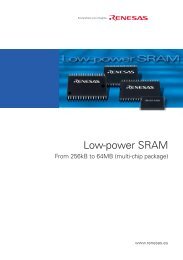SL811HS Embedded USB Host/Slave Controller
SL811HS Embedded USB Host/Slave Controller
SL811HS Embedded USB Host/Slave Controller
Create successful ePaper yourself
Turn your PDF publications into a flip-book with our unique Google optimized e-Paper software.
<strong>SL811HS</strong><br />
PLL Clock Generator<br />
Either a 12 MHz or a 48 MHz external crystal is used with the<br />
<strong>SL811HS</strong> [1] . Two pins, X1 and X2, are provided to connect a<br />
low cost crystal circuit to the device as shown in Figure 2 and<br />
Figure 3. Use an external clock source if available in the application<br />
instead of the crystal circuit by connecting the source<br />
directly to the X1 input pin. When a clock is used, the X2 pin<br />
is not connected.<br />
When the CM pin is tied to a logic 0, the internal PLL is<br />
bypassed so the clock source must meet the timing requirements<br />
specified by the <strong>USB</strong> specification.<br />
Figure 2. Full Speed 48 MHz Crystal Circuit<br />
Cin<br />
22 pF<br />
X1<br />
Cbk<br />
0.01 μF<br />
Lin<br />
2.2 μH<br />
Rf<br />
1M<br />
X1<br />
48 MHz, series, 20-pF load<br />
X2<br />
Rs<br />
100<br />
Cout<br />
22 pF<br />
Typical Crystal Requirements<br />
The following are examples of ‘typical requirements.’ Note that<br />
these specifications are generally found as standard crystal<br />
values and are less expensive than custom values. If crystals<br />
are used in series circuits, load capacitance is not applicable.<br />
Load capacitance of parallel circuits is a requirement. 48 MHz<br />
third overtone crystals require the Cin/Lin filter to guarantee 48<br />
MHz operation.<br />
12 MHz Crystals:<br />
Frequency Tolerance:<br />
±100 ppm or better<br />
Operating Temperature Range: 0°C to 70°C<br />
Frequency:<br />
Frequency Drift over Temperature:<br />
ESR (Series Resistance):<br />
Load Capacitance:<br />
Shunt Capacitance:<br />
Drive Level:<br />
Operating Mode:<br />
48 MHz Crystals:<br />
Frequency Tolerance:<br />
12 MHz<br />
± 50 ppm<br />
60Ω<br />
10 pF min.<br />
7 pF max.<br />
0.1–0.5 mW<br />
fundamental<br />
±100 ppm or better<br />
Operating Temperature Range: 0°C to 70°C<br />
Frequency:<br />
Frequency Drift over Temperature:<br />
ESR (Series Resistance):<br />
Load Capacitance:<br />
Shunt Capacitance:<br />
Drive Level:<br />
Operating Mode:<br />
48 MHz<br />
± 50 ppm<br />
40 Ω<br />
10 pF min.<br />
7 pF max.<br />
0.1–0.5 mW<br />
third overtone<br />
X1<br />
Figure 3. Optional 12 MHz Crystal Circuit<br />
Cin<br />
22 pF<br />
Rf<br />
1M<br />
X1<br />
12 MHz , series, 20-pF load<br />
Cout<br />
22 pF<br />
<strong>USB</strong> Transceiver<br />
The <strong>SL811HS</strong> has a built in transceiver that meets <strong>USB</strong> Specification<br />
1.1. The transceiver is capable of transmitting and<br />
receiving serial data at <strong>USB</strong> full speed (12 Mbits) and low<br />
speed (1.5 Mbits). The driver portion of the transceiver is differential<br />
while the receiver section is comprised of a differential<br />
receiver and two single-ended receivers. Internally, the transceiver<br />
interfaces to the Serial Interface Engine (SIE) logic.<br />
Externally, the transceiver connects to the physical layer of the<br />
<strong>USB</strong>.<br />
<strong>SL811HS</strong> Registers<br />
Operation and control of the <strong>SL811HS</strong> is managed through<br />
internal registers. When operating in Master/<strong>Host</strong> mode, the<br />
first 16 address locations are defined as register space. In<br />
<strong>Slave</strong>/Peripheral mode, the first 64 bytes are defined as<br />
register space. The register definitions vary greatly between<br />
each mode of operation and are defined separately in this<br />
document (section “<strong>SL811HS</strong> Master (<strong>Host</strong>) Mode Registers”<br />
on page 4 describes <strong>Host</strong> register definitions, while section<br />
Note<br />
1. CM (Clock Multiply) pin of the <strong>SL811HS</strong> must be tied to GND when 48 MHz crystal circuit or 48 MHz clock source is used.<br />
X2<br />
Rs<br />
100<br />
Document 38-08008 Rev. *D Page 3 of 32<br />
[+] Feedback



